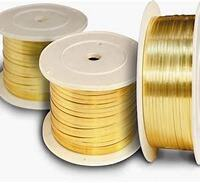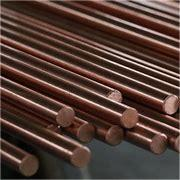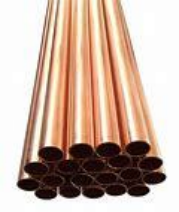1. Introduction
Copper rod might sound like a simple piece of metal, but it’s actually a cornerstone in countless industries—from electrical engineering to plumbing and metal fabrication. Whether you’re installing a grounding system, welding copper components, or sourcing raw materials for manufacturing, understanding what a copper rod is and how it’s used can save time, money, and headaches. In this guide, we’ll break down everything you need to know about copper rod, including its variations like rod copper, copper earth rod, and copper brazing rod.

2. What Is a Copper Rod?
A copper rod is a solid, cylindrical bar made from high-conductivity copper, typically produced through hot or cold rolling. Known for its excellent electrical and thermal conductivity, corrosion resistance, and ductility, copper rod serves as a foundational material in electrical wiring, grounding systems, and industrial fabrication. Depending on the application, you’ll find different grades and forms—such as oxygen-free copper or electrolytic-tough-pitch (ETP) copper.
3. Common Types and Applications
Copper rods come in several specialized forms, each tailored to specific uses:

- Copper earth rod and earthing rod copper: Used in grounding systems to safely channel electrical faults into the earth. These are often made from solid copper or copper-bonded steel for durability and conductivity.
- Copper bonded earthing rod and copper bonded ground rod: These feature a steel core with a thick layer of copper bonded to the surface, offering strength and corrosion resistance at a lower cost than solid copper.
- Copper clad ground rod and copper clad steel earth rod: Similar to bonded rods but with a thinner copper layer applied via cladding. Still effective for many earthing applications.
- Copper brazing rod and copper to copper brazing rods: Used in joining copper parts without melting the base metal. Ideal for HVAC, plumbing, and electrical work.
- Copper welding rod and copper rod for welding: Designed for copper rod welding tasks, especially when joining copper to copper. Options like copper to copper welding rod ensure strong, conductive joints.
4. Copper Rod vs. Related Products
While ‘copper rod’ refers specifically to round, solid bars, it’s often confused with similar copper products. For instance, copper round bar and round bar copper are essentially the same as copper rod—just different naming conventions. Meanwhile, copper strip (or copperstrip) refers to flat, thin sheets used in busbars, electronics, or earthing strips like the copper earth strip 25x3mm. Thin copper strips, beryllium copper strip, and nickel plated copper strip serve niche roles in aerospace, electronics, and high-stress environments.

If you’re stripping wire for scrap or recycling, you might deal with stripping copper wire or the best way to strip copper cable. Note: burning copper wire for scrap is dangerous and illegal in many areas—mechanical strippers are safer and more efficient.
5. Copper in Plumbing and HVAC
Beyond rods and strips, copper plays a huge role in fluid transport. Copper pipework, copper tubing, and air conditioning copper pipe (often called aircon copper tube) are standard in residential and commercial systems. Sizes like 15mm copper pipe, 22mm copper tube, or 3/4 copper tubing are common, with proper copper pipe soldering ensuring leak-free joints. Prices vary by region and thickness—so checking ac copper pipe price or air conditioner copper pipe price helps with budgeting.
6. Pricing and Sourcing
Copper rod price fluctuates with global metal markets, influenced by factors like purity, diameter, and quantity. Similarly, earthing rod price depends on whether you choose solid copper, copper bonded, or copper clad steel. For strips, copper strip price varies by thickness (e.g., 1mm copper strip) and alloy (e.g., copper alloy strip or beryllium copper). If you’re looking locally, searching for ‘copper strip near me’ or ‘copper bars for sale’ can yield nearby suppliers.
Other related items include copper bar, copper ingot, copper bus bar, and flexible copper bus bar—all used in power distribution. Cu bars and copper flat bar are essential in switchgear and industrial panels. Even niche items like copper tape for snails (used in gardening) or copper edging strip show copper’s versatility.
7. Practical Tips and Considerations
When working with copper components:
- Always match the rod or strip type to your application—e.g., use copper bonded steel for deep-earth grounding where tensile strength matters.
- For welding or brazing, select the right filler: copper to copper welding rod for pure joints, or specialized alloys for dissimilar metals.
- Avoid shortcuts like burning insulation off wire—it releases toxic fumes and degrades copper value. Use the fast way to strip copper wire: mechanical or automatic strippers.
- Store copper away from moisture and acidic materials to prevent tarnishing, especially for high-purity grades.
8. Conclusion
From the humble copper rod to advanced copper strip rolls and HVAC-grade tubing, copper remains indispensable across modern infrastructure. Whether you’re an electrician installing an earthing rod copper system, a plumber bending 15mm copper pipe, or a recycler stripping copper wire for scrap, knowing the right form, grade, and application ensures efficiency and safety. With options like copper bonded, copper clad, and specialty alloys, there’s a copper solution for nearly every technical challenge.
Our Website founded on October 17, 2012, is a high-tech enterprise committed to the research and development, production, processing, sales and technical services of ceramic relative materials such as What. Our products includes but not limited to Boron Carbide Ceramic Products, Boron Nitride Ceramic Products, Silicon Carbide Ceramic Products, Silicon Nitride Ceramic Products, Zirconium Dioxide Ceramic Products, etc. If you are interested, please feel free to contact us.

